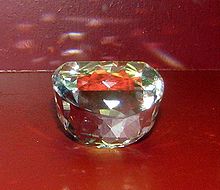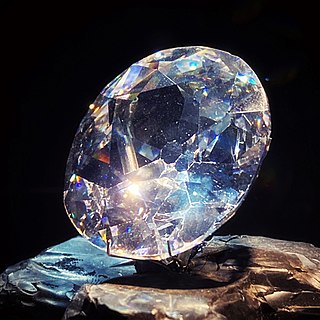
The Koh-i-Noor, also spelled Kohinoor and Koh-i-Nur, is one of the largest cut diamonds in the world, weighing 105.6 carats (21.12 g). It is part of the Crown Jewels of the United Kingdom. The diamond is currently set in the Crown of Queen Elizabeth The Queen Mother.

The Cullinan Diamond is the largest gem-quality rough diamond ever found, weighing 3,106 carats (621.20 g), discovered at the Premier No.2 mine in Cullinan, South Africa, on 26 January 1905. It was named after Thomas Cullinan, the owner of the mine. In April 1905, it was put on sale in London, but despite considerable interest, it was still unsold after two years. In 1907, the Transvaal Colony government bought the Cullinan and Prime Minister Louis Botha presented it to Edward VII, the British king who reigned over the territory, and it was cut by Joseph Asscher & Co. in Amsterdam.

The Peacock Throne was a famous jewelled throne that was the seat of the emperors of the Mughal Empire in India. It was commissioned in the early 17th century by Emperor Shah Jahan and was located in the Diwan-i-Khas in the Red Fort of Delhi. It was named after a peacock as two peacocks are shown dancing at its rear.

The Crown Jewels of the United Kingdom, originally the Crown Jewels of England, are a collection of royal ceremonial objects kept in the Tower of London, which include the coronation regalia and vestments worn by British monarchs.
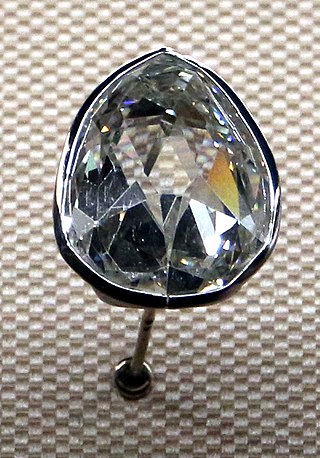
The Sancy, a pale yellow diamond of 55.23 carats (11.046 g), was once reputed to have belonged to the Mughals of antiquity, but it is more likely of Indian origin owing to its cut, which is unusual by Western standards. The stone has been owned by a number of important figures in European history, such as Charles the Bold, James VI and I, and the Astor family.

The French Crown Jewels comprise the crowns, orb, sceptres, diadems and jewels that were symbols of Royal power between 752 and 1825. These were worn by many Kings and Queens of France as well as Emperor Napoleon. The set was finally broken up, with most of it sold off in 1885 by the Third Republic. The surviving French Crown Jewels, principally a set of historic crowns, diadems and parures, are mainly on display in the Galerie d'Apollon of the Louvre, France's premier museum and former royal palace, together with the Regent Diamond, the Sancy Diamond and the 105-carat (21.0 g) Côte-de-Bretagne red spinel, carved into the form of a dragon. In addition, some gemstones and jewels are on display in the Treasury vault of the Mineralogy gallery in the National Museum of Natural History.

The Imperial crown of Russia, also known as the great imperial crown, was used for the coronation of the monarchs of Russia from 1762 until the Russian monarchy's abolition in 1917. The great imperial crown was first used in the coronation by Catherine the Great, and it was last worn at the coronation of Nicholas II. It was displayed prominently next to Nicholas II on a cushion at the State Opening of the Russian Duma inside the Winter Palace in St. Petersburg in 1906. It survived the 1917 revolution and is currently on display in Moscow at the Kremlin Armoury's State Diamond Fund.

The Iranian National Jewels, originally the Iranian Crown Jewels, include elaborate crowns, thirty tiaras, and numerous aigrettes, a dozen bejeweled swords and shields, a number of unset precious gems, numerous plates and other dining services cast in precious metals and encrusted with gems, and several other more unusual items collected or worn by the Persian monarchs from the 16th century and on. The collection is housed at the Treasury of National Jewels, situated inside the Central Bank of Iran on Tehran's Ferdowsi Avenue.

Harry Winston was an American jeweler. He donated the Hope Diamond to the Smithsonian Institution in 1958 after owning it for a decade. He also traded the Portuguese Diamond to the Smithsonian in 1963 in exchange for 3,800 carats of small diamonds.

The Shah Diamond was found at the Golconda mines in what is now Telangana, South India, probably in 1450, and it is currently held in the Diamond Fund collection of Moscow's Kremlin Armoury.
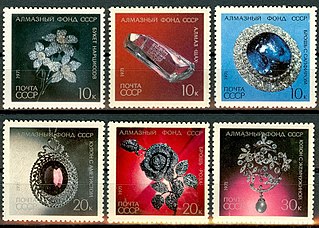
The Diamond Fund is a unique collection of gems, jewelry and natural nuggets, which are stored and exhibited in the Kremlin Armoury in Russia. The Fund was opened in 1967 and its collection dates back to the Russian Crown treasury instituted by Emperor Peter I of Russia in 1719.

Prince Grigory Grigoryevich Orlov was a favourite of the Empress Catherine the Great of Russia. He became a leader of the 1762 coup which overthrew Catherine's husband Peter III of Russia and installed Catherine as empress. For some years he was virtually co-ruler with her, but his repeated infidelities and the enmity of Catherine's other advisers led to his fall from power.

The Nassak Diamond is a large, 43.38 carats (8.676 g) Golconda Diamond that originated as a larger 89 carat diamond in the 15th century in India. Found in Golconda mines of Kollur and originally cut in India, the diamond was the adornment in the Trimbakeshwar Shiva Temple, near Nashik, in the state of Maharashtra, India from at least 1500 to 1817. The British East India Company captured the diamond through the Third Anglo-Maratha War and sold it to British jewellers Rundell and Bridge in 1818. Rundell and Bridge recut the diamond in 1818, after which it made its way into the handle of the 1st Marquess of Westminster's dress sword.

Brown diamonds are the most common color variety of natural diamonds. In most mines, brown diamonds account for 15% of production. The brown color makes them less attractive to some people as gemstones, and most are used for industrial purposes. However, improved marketing programs, especially in Australia and the United States, have resulted in brown diamonds becoming valued as gemstones and even referred to as chocolate diamonds.
Graff is a British multinational jeweller based in London. It was founded by British jeweller Laurence Graff in 1960. A vertically integrated company, Graff operations comprise the design, manufacture and retail distribution of jewellery and watches.

Regalia of the Russian tsars are the insignia of tsars and emperors of Russia, who ruled from the 13th to the 19th century. Over the centuries, the specific items used by Tsars changed greatly; the largest such shift occurred in the 18th century, when Peter the Great reformed the state to align it more closely with Western European monarchies.

Great Mogul is believed to have been discovered around 1650, most probably around the Kollur Mine in the Golconda region of southern India. Tavernier described the diamond thus: "The stone is of the same form as if one cut an egg through the middle".
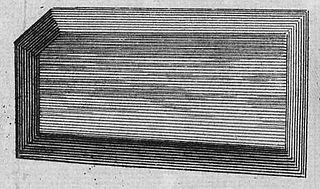
The Great Table was a large pink diamond that had been studded in the throne of the Mughal emperor Shah Jahan. It has been described in the book of the French jeweller Jean-Baptiste Tavernier in 1642, who gave it its name.

Jérémie Pauzié was a Genevan diamond jeweler, artist and memoirist, known for his work for the Russian Imperial court and the Imperial Crown of Russia, which he created with the court's jeweler Georg Friedrich Ekart.

Golconda diamonds are mined in the Godavari delta region of the present-day states Andhra Pradesh and Telangana, India. Golconda Fort in the western part of modern-day Hyderabad, was a seat of the Golconda Sultanate and became an important centre for diamond enhancement, lapidary and trading. Golconda diamonds are graded as Type IIa, formed of pure carbon, are devoid of nitrogen, and are large with high clarity. They are often described as diamonds of the first water, making them among history's most celebrated diamonds. The word "Golconda diamond" became symbolic of diamonds of incomparable quality.
